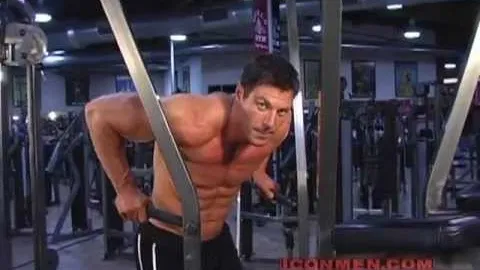


Chest Dip Exercise: Build Strength and Sculpt Your Upper Body
Introduction The chest dip exercise is an effective compound movement that targets multiple muscles in your upper body. It is often considered a staple exercise for building strength and sculpting a well-defined chest. In this article, we will guide you through the proper form and technique for performing chest dips, as well as discuss the benefits and variations of this exercise.
Form and Technique To perform chest dips, start by gripping parallel bars with your arms fully extended and supporting your bodyweight. Position your hands slightly wider than shoulder-width apart, while keeping your elbows tucked in by your sides. Lean forward slightly and lower your body until your shoulders are below your elbows. Then, push yourself back up to the starting position by straightening your arms. Focus on maintaining control throughout the movement and engaging your chest, triceps, and shoulders.
Benefits of Chest Dips
Muscle Building: Chest dips primarily target your pectoralis major (chest muscles) and triceps brachii (muscles on the back of your upper arm). This exercise helps develop strength and size in these muscle groups, resulting in a more defined upper body.
Comprehensive Upper Body Workout: Unlike traditional chest exercises such as push-ups or bench presses, chest dips engage multiple muscle groups simultaneously. In addition to chest and triceps, dips also activate your deltoids (shoulders), rhomboids (upper back), and even your core muscles. This makes chest dips an efficient exercise for overall upper body development.
Improved Strength and Stability: Chest dips require significant upper body strength, particularly in your chest, triceps, and shoulders. By regularly incorporating this exercise into your workout routine, you can increase your overall strength and enhance stability in your upper body.
Functional Movement: The chest dip exercise mimics the movement pattern involved in pushing yourself upward from a lower position, such as getting out of a chair or performing activities like climbing. Incorporating chest dips into your training can improve your functional strength, making everyday movements easier.
Versatility and Accessibility: Chest dips can be performed using parallel bars at the gym, or with the assistance of dip bars or a dip station. Additionally, if you don't have access to specialized equipment, you can modify the exercise by using a sturdy bench, steps, or even parallel bars at a local playground. This versatility allows you to perform chest dips almost anywhere.
Variations of Chest Dips
Weighted Chest Dips: As you become more comfortable with bodyweight chest dips, you can add additional resistance to further challenge your muscles. This can be done by wearing a weighted vest or attaching a weight belt with a plate or dumbbell between your legs.
Assisted Chest Dips: If you find chest dips too challenging initially, you can use an assisted dip machine or resistance bands to help counterbalance your bodyweight. This modification allows you to gradually build up your strength and eventually perform unassisted dips.
Narrow Grip Chest Dips: Altering your grip by placing your hands closer together targets your triceps more intensively. This variation shifts the emphasis away from the chest muscles and places greater demand on the muscles at the back of your upper arm.
Ring Chest Dips: Performing chest dips with gymnastic rings or suspension straps adds an element of instability to the exercise. This requires more activation of your core muscles and challenges your stabilizer muscles to a greater extent.
Tips for Performing Chest Dips Safely
Warm-up: Prior to performing chest dips, ensure a proper warm-up that includes dynamic stretching and mobility exercises for your chest, shoulders, and arms.
Proper Form: Maintain a neutral spine position throughout the exercise. Avoid excessive arching or rounding of your back. Keep your movements controlled and avoid using momentum to lift yourself.
Joint Alignment: Keep your elbows tucked in during the movement to minimize stress on your shoulder joints. Ensure that your wrists are in a neutral position and avoid hyperextension.
Progress Gradually: Start with bodyweight chest dips and gradually increase the challenge by adding additional resistance or exploring variations. Focus on proper form and gradually increase the number of repetitions and sets over time.
Listen to Your Body: If you experience any pain or discomfort, especially in your shoulders or wrists, modify the exercise or consult a fitness professional to ensure you're performing it correctly.
Conclusion The chest dip exercise is a versatile and effective compound movement that offers numerous benefits for building upper body strength and sculpting your chest muscles. By incorporating chest dips into your workout routine, you can target multiple muscle groups simultaneously, improve functional strength, and enhance overall upper body stability. Remember to prioritize correct form and technique, gradually progress your intensity, and always listen to your body to prevent injuries. So, give chest dips a try and watch your upper body strength and muscle definition soar to new heights!
If you're looking for a gym, fitness club or yoga studio, you've come to the right place.
You can find information about gyms in your area. Browse catalog of gyms and find gyms with classes which are you looking for.
On gym page you can find simple information like address, phone or website. You can find list of available classes. You can check availability of personal training or small group classes. On place page you can also see information about open hours.
You can find gyms near you with amenities, courts, studios and equipments.
Use our map to find gym at your city or district.
In Gym Navigator you can find list of exercises with movies for many body parts.
You can browse exercises catalog and find exercises the best of you.
You can also find exercises grouped into workout plans, which you can use to improve you body. Each routine show you exercises one by one and give you possibility to count you progress and count down rest time.